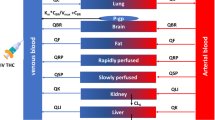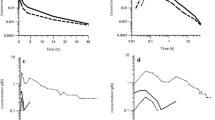Abstract
Δ9-Tetrahydrocannobinol (THC), the main psychoactive compound of Cannabis, is known to have a long terminal half-life. However, this characteristic is often ignored in pharmacokinetic (PK) studies of THC, which may affect the accuracy of predictions in different pharmacologic areas. For therapeutic use for example, it is important to accurately describe the terminal phase of THC to describe accumulation of the drug. In early clinical research, the THC challenge test can be optimized through more accurate predictions of the dosing sequence and the wash-out between occasions in a crossover setting, which is mainly determined by the terminal half-life of the compound. The purpose of this study is to better quantify the long-term pharmacokinetics of THC. A population-based PK model for THC was developed describing the profile up to 48 h after an oral, intravenous, and pulmonary dose of THC in humans. In contrast to earlier models, the current model integrates all three major administration routes and covers the long terminal phase of THC. Results show that THC has a fast initial and intermediate half-life, while the apparent terminal half-life is long (21.5 h), with a clearance of 38.8 L/h. Because the current model characterizes the long-term pharmacokinetics, it can be used to assess the accumulation of THC in a multiple-dose setting and to forecast concentration profiles of the drug under many different dosing regimens or administration routes. Additionally, this model could provide helpful insights into the THC challenge test used for the development of (novel) compounds targeting the cannabinoid system for different therapeutic applications and could improve decision making in future clinical trials.







Similar content being viewed by others
References
Ashton CH. Pharmacology and effects of cannabis: a brief review. Br J Psychiatry. 2001;178:101–6.
Hazekamp A, Grotenhermen F. Review on clinical studies with cannabis and cannabinoids 2005–2009. Cannabinoids. 2010;5:1–21.
Kalant H. Medicinal use of cannabis: history and current status. Pain Res Manag. 2001;6:80–91.
Devane WA, Dysarz FA III, Johnson MR, Melvin LS, Howlett AC. Determination and characterization of a cannabinoid receptor in rat brain. Mol Pharmacol. 1988;34:605–13.
Glass M, Northup JK. Agonist selective regulation of G proteins by cannabinoid CB(1) and CB(2) receptors. Mol Pharmacol. 1999;56:1362–9.
Klumpers LE, Roy C, Ferron G, Turpault S, Poitiers F, Pinquier JL, et al. Surinabant, a selective cannabinoid receptor type 1 antagonist, inhibits delta 9-tetrahydrocannabinol-induced central nervous system and heart rate effects in humans. Br J Clin Pharmacol. 2013;76:65–77.
Grotenhermen F. Clinical pharmacokinetics of cannabinoids. J Cannabis Ther. 2003;3:3–51.
Lindgren JE, Ohlsson A, Agurell S, Hollister L, Gillespie H. Clinical effects and plasma levels of delta 9-tetrahydrocannabinol (delta 9-THC) in heavy and light users of cannabis. Psychopharmacology (Berl). 1981;74:208–12.
Ohlsson A, Lindgren JE, Wahlen A, Agurell S, Hollister LE, Gillespie HK. Plasma delta-9 tetrahydrocannabinol concentrations and clinical effects after oral and intravenous administration and smoking. Clin Pharmacol Ther. 1980;28:409–16.
Watanabe K, Matsunaga T, Yamamoto I, Funae Y, Yoshimura H. Involvement of CYP2C in the metabolism of cannabinoids by human hepatic microsomes from an old woman. Biol Pharm Bull. 1995;18:1138–41.
Watanabe K, Yamaori S, Funahashi T, Kimura T, Yamamoto I. Cytochrome P450 enzymes involved in the metabolism of tetrahydrocannabinols and cannabinol by human hepatic microsomes. Life Sci. 2007;80:1415–9.
Perez-Reyes M, Timmons MC, Lipton MA, Davis KH, Wall ME. Intravenous injection in man of 9-tetrahydrocannabinol and 11-OH-9-tetrahydrocannabinol. Science. 1972;177:633–5.
Garrett ER, Hunt CA. Physiochemical properties, solubility, and protein binding of delta 9-tetrahydrocannabinol. J Pharm Sci. 1974;63:1056–64.
Hunt CA, Jones RT. Tolerance and disposition of tetrahydrocannabinol in man. J Pharmacol Exp Ther. 1980;215:35–44.
Ho BT, Fritchie GE, Kralik PM, Englert LF, McIsaac WM, Idanpaan-Heikkila J. Distribution of tritiated-1 delta 9 tetrahydrocannabinol in rat tissues after inhalation. J Pharm Pharmacol. 1970;22:538–9.
Johansson E, Noren K, Sjovall J, Halldin MM. Determination of delta 1-tetrahydrocannabinol in human fat biopsies from marihuana users by gas chromatography-mass spectrometry. Biomed Chromatogr. 1989;3:35–8.
Ohlsson A, Lindgren JE, Wahlen A, Agurell S, Hollister LE, Gillespie HK. Single dose kinetics of deuterium labelled delta 1-tetrahydrocannabinol in heavy and light cannabis users. Biomed Mass Spectrom. 1982;9:6–10.
Leuschner JT, Harvey DJ, Bullingham RE, Paton WD. Pharmacokinetics of delta 9-tetrahydrocannabinol in rabbits following single or multiple intravenous doses. Drug Metab Dispos. 1986;14:230–8.
Lemberger L, Tamarkin NR, Axelrod J, Kopin IJ. Delta-9-tetrahydrocannabinol: metabolism and disposition in long-term marihuana smokers. Science. 1971;173:72–4.
Wall ME, Sadler BM, Brine D, Taylor H, Perez-Reyes M. Metabolism, disposition, and kinetics of delta-9-tetrahydrocannabinol in men and women. Clin Pharmacol Ther. 1983;34:352–63.
Chiang CW, Barnett G. Marijuana effect and delta-9-tetrahydrocannabinol plasma level. Clin Pharmacol Ther. 1984;36:234–8.
Barnett G, Chiang CW, Perez-Reyes M, Owens SM. Kinetic study of smoking marijuana. J Pharmacokinet Biopharm. 1982;10:495–506.
Cocchetto DM, Owens SM, Perez-Reyes M, DiGuiseppi S, Miller LL. Relationship between plasma delta-9-tetrahydrocannabinol concentration and pharmacologic effects in man. Psychopharmacology (Berl). 1981;75:158–64.
Harder S, Rietbrock S. Concentration-effect relationship of delta-9-tetrahydrocannabiol and prediction of psychotropic effects after smoking marijuana. Int J Clin Pharmacol Ther. 1997;35:155–9.
Hunault CC, van Eijkeren JC, Mensinga TT, de VI, Leenders ME, Meulenbelt J. Disposition of smoked cannabis with high delta(9)-tetrahydrocannabinol content: a kinetic model. Toxicol Appl Pharmacol. 2010;246:148–53.
Strougo A, Zuurman L, Roy C, Pinquier JL, van Gerven JM, Cohen AF, et al. Modelling of the concentration-effect relationship of THC on central nervous system parameters and heart rate: insight into its mechanisms of action and a tool for clinical research and development of cannabinoids. J Psychopharmacol. 2008;22:717–26.
Klumpers LE, Beumer TL, van Hasselt JG, Lipplaa A, Karger LB, Kleinloog HD, et al. Novel delta(9)-tetrahydrocannabinol formulation Namisol(R) has beneficial pharmacokinetics and promising pharmacodynamic effects. Br J Clin Pharmacol. 2011;74:42–53.
Klumpers LE, Cole DM, Khalili-Mahani N, Soeter RP, Te Beek ET, Rombouts SA, et al. Manipulating brain connectivity with delta(9)-tetrahydrocannabinol: a pharmacological resting state FMRI study. Neuroimage. 2012;63:1701–11.
Kleinloog D, Liem-Moolenaar M, Jacobs G, Klaassen E, de Kam M, Hijman R, et al. Does olanzapine inhibit the psychomimetic effects of delta(9)-tetrahydrocannabinol? J Psychopharmacol. 2012;26:1307–16.
Morrison PD, Zois V, McKeown DA, Lee TD, Holt DW, Powell JF, et al. The acute effects of synthetic intravenous delta 9-tetrahydrocannabinol on psychosis, mood and cognitive functioning. Psychol Med. 2009;39:1607–16.
Barkus E, Morrison PD, Vuletic D, Dickson JC, Ell PJ, Pilowsky LS, et al. Does intravenous delta 9-tetrahydrocannabinol increase dopamine release? A SPET study. J Psychopharmacol. 2011;25:1462–8.
Morrison PD, Nottage J, Stone JM, Bhattacharyya S, Tunstall N, Brenneisen R, et al. Disruption of frontal theta coherence by delta 9-tetrahydrocannabinol is associated with positive psychotic symptoms. Neuropsychopharmacology. 2011;36:827–36.
Bhattacharyya S, Morrison PD, Fusar-Poli P, Martin-Santos R, Borgwardt S, Winton-Brown T, et al. Opposite effects of delta-9-tetrahydrocannabinol and cannabidiol on human brain function and psychopathology. Neuropsychopharmacology. 2010;35:764–74.
Sheiner LB, Rosenberg B, Marathe VV. Estimation of population characteristics of pharmacokinetic parameters from routine clinical data. J Pharmacokinet Biopharm. 1977;5:445–79.
Promasys 6.1 version. Leiden: Promasys BV; 2011.
Beal SL, Sheiner LB, Boeckmann A, Bauer RJ. NONMEM User’s Guides (1989–2009). SSLBBA&BRJ. 2009.
R Development Core Team. R: a language and environment for statistical computing. RFfSCVA. 2011.
Lindbom L, Pihlgren P, Jonsson EN. PsN-Toolkit: a collection of computer intensive statistical methods for non-linear mixed effect modeling using NONMEM. Comput Methods Programs Biomed. 2005;79:241–57.
Litterst CL, Flora KP, Cradock JC. Bioavailability of delta-9-tetrahydrocannabinol-derived radioactivity following intramuscular administration of delta-9-11-C-14-tetrahydrocannabinol to rabbits. Res Commun Subst Abuse. 1982;3:453–65.
Acknowledgments
The authors would like to acknowledge the contribution of Jasper Stevens for his review of the manuscript and advice during manuscript development.
Conflict of interest
The authors would like to declare the following conflicts of interest; Study CHDR0828 was sponsored by ECHO Pharmaceuticals. TLB is an employee of ECHO Pharmaceuticals; Support for Dr. Paul Morrison was from the MRC (UK).
Author information
Authors and Affiliations
Corresponding author
Appendix
Appendix

and
where A i is the amount in compartment i, k ij are the rate constants for the exchange rate between compartments i and j, R oral(t) is the (instantaneous) administration rate in the dose depot with bioavailability F 1, R IV(t) is the infusion rate (100 % bioavailability), R inf(t) the (instantaneous) inhalation rate with bioavailality F 2, K a is the absorption rate constant, I inh, I inf, and I oral are indicators for the administration route (true or false), C plasma is the plasma concentration, and V 2 is the central distribution volume.
Rights and permissions
About this article
Cite this article
Heuberger, J.A.A.C., Guan, Z., Oyetayo, OO. et al. Population Pharmacokinetic Model of THC Integrates Oral, Intravenous, and Pulmonary Dosing and Characterizes Short- and Long-term Pharmacokinetics. Clin Pharmacokinet 54, 209–219 (2015). https://doi.org/10.1007/s40262-014-0195-5
Published:
Issue Date:
DOI: https://doi.org/10.1007/s40262-014-0195-5




